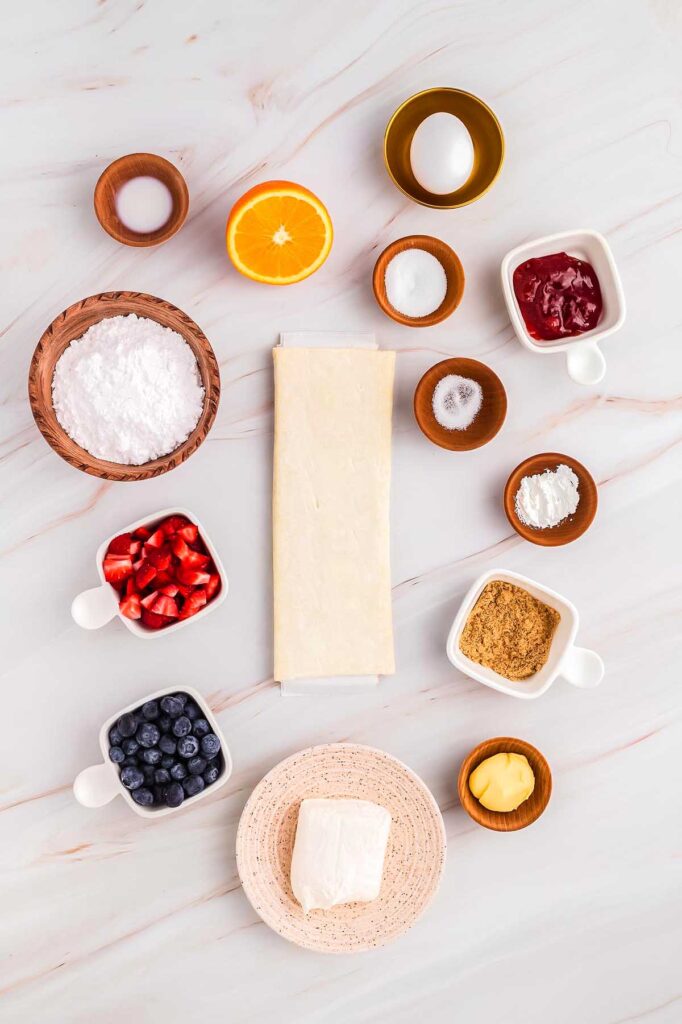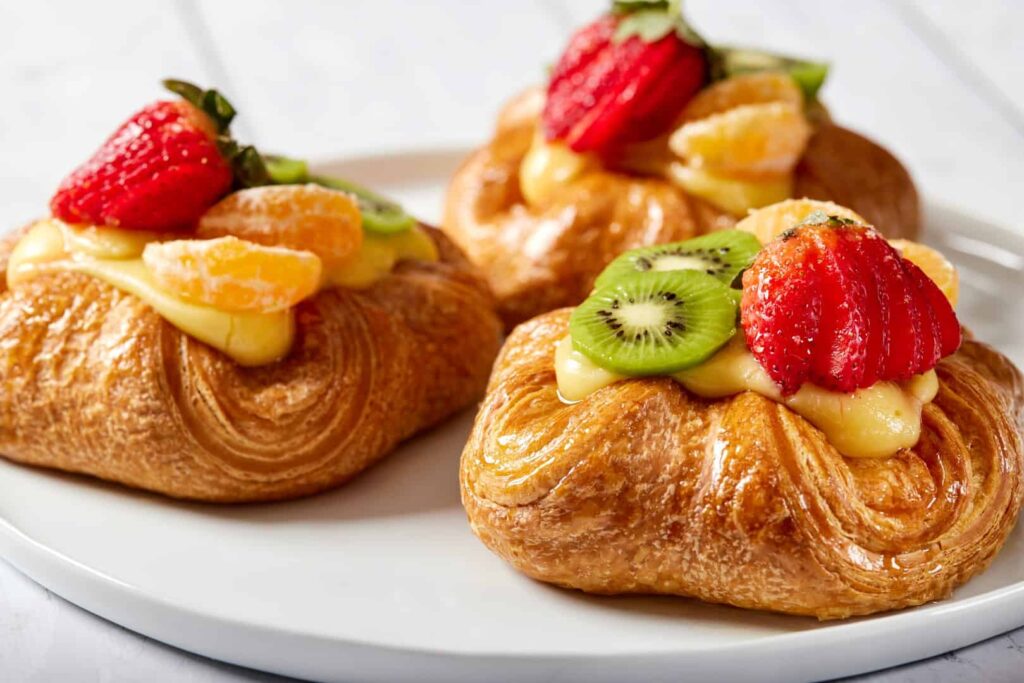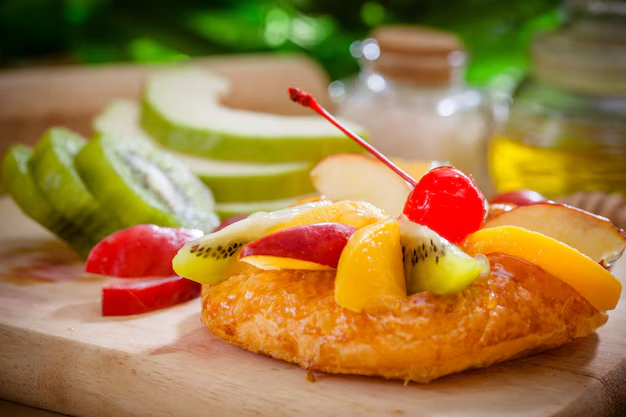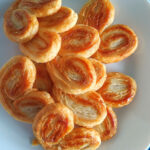INTRODUCTION ABOUT FRUIT DANISH
- The Pastry: The base of a fruit Danish is a layered, laminated dough similar to puff pastry but typically enriched with yeast, sugar, and often eggs and milk.This lamination process involves repeatedly folding butter into the dough, creating numerous thin layers that expand and suparare when baked, resulting in a light, crisp exterior and a softer interior.
- The Filling: Fruit danishes are filled with a variety of sweet fruit preparations. Common choices include:
- Jams or preserves: Raspberry, strawberry, apricot, and cherry are popular options.
- Fresh fruit: Berries like strawberries, raspberries, blueberries, blackberries, or peaches are frequently used, often combined with a small amount of sugar and cornstarch to thicken the juices during baking.

- Pastry cream: A rich, custard like cream is sometimes used as a base layer for the fruit filling, adding a creamy element to the pastry.
- Taste and Texture: Fruit danishes offer a delightful contrast of textures and flavours. The pastry itself is flaky , crispy, buttery, and slightly sweet. The fruit filling provides a burst of sweet and often slightly tart flavour. Some danishes also incorporate cream cheese fillings, adding a rich, creamy element that complements the fruit.
- History and Origin: The origin Danish pastries can be traced back to Denmark in the mid- 19th century. Austrian bakers, who were brought in during a bakery workers’ strike, are credited with introducing the lamination techniques. Danish bakers adapted these techniques, incorporating more eggs and butter into the dough, leading to the creation of the distinct Danish pastry known as ” viennese bread”. Danish pastry was later popularized in the United States by Danish immigrants in the early 20th century.
In essence, a fruit Danish is a delicious and versatile pastry with a rich history, known for its layered dough and flavourful fruit fillings.
Best Combinations
- Blueberry Cream Cheese: A classic combination of blueberries and cream cheese.
- Apple Cinnamon: Apples with cinnamon is a warm and comforting flavor.
- Mixed Fruit: A mix of various fruits offers a diverse flavor profile
Fruit Danish Pastry Recipe
Ingredients Table
| Component | Ingredient | Quantity |
|---|---|---|
| Dough | All-purpose flour | 2 ½ cups (315g) |
| Unsalted butter (cold) | 1 cup (225g) | |
| Active dry yeast | 2 ¼ tsp (1 packet) | |
| Warm milk (110°F/43°C) | ¾ cup (180ml) | |
| Granulated sugar | 2 tbsp | |
| Salt | ½ tsp | |
| Egg | 1 | |
| Filling | Cream cheese (softened) | ¾ cup (170g) |
| Powdered sugar | ¼ cup (30g) | |
| Vanilla extract | 1 tsp | |
| Assorted fresh fruits | 1 cup (sliced) | |
| Egg Wash | Egg yolk | 1 |
| Milk | 1 tbsp | |
| Glaze (opt.) | Apricot jam (for brushing) | ¼ cup |

Instructions
1. Prepare the Dough
- In a small bowl, mix warm milk, sugar, and yeast. Let sit for 5–10 minutes until frothy.
- In a large bowl, combine flour and salt. Cut in cold butter until mixture resembles coarse crumbs.
- Add the yeast mixture and egg. Mix until dough forms (don’t over-knead).
- Wrap and chill dough in the fridge for 1 hour.
2. Roll & Fold (laminate):
- Roll the chilled dough into a rectangle.
- Fold into thirds (like a letter). Rotate and repeat this fold-rolling process 3 times.
- Chill for 30 minutes between folds.
3. Make the Filling:
- Beat softened cream cheese, powdered sugar, and vanilla until smooth. Set aside.
4. Shape the Pastries:
- Roll dough to ¼-inch thick. Cut into 3×3 inch squares.
- Score a smaller square inside, then fold corners toward the center or twist for a pinwheel shape.
- Place 1 tbsp of cream cheese filling in the center of each.
5. Add Fruit:
- Top with sliced fresh fruits (berries, peaches, kiwi, etc.).
- Mix egg yolk + milk for egg wash. Brush edges of pastry.
6. Bake:
- Preheat oven to 200°C (400°F).
- Bake for 15–18 minutes until golden brown and puffed.
7. Glaze (optional):
- Warm apricot jam slightly and brush over warm pastries for shine.
Suggested Fruit Toppings:
- Strawberries
- Blueberries
- Kiwi
- Mango
- Peaches
- Grapes

Types of Fruit Danish
| Type | Description |
|---|---|
| Apple Danish | Filled with spiced apple compote, sometimes with cinnamon and raisins. |
| Cherry Danish | Sweet or tart cherries in a glossy glaze, often paired with cream cheese. |
| Blueberry Danish | Juicy blueberries in syrup or preserves, sometimes with lemon zest. |
| Peach Danish | Made with fresh or canned peaches, often lightly spiced or glazed. |
| Strawberry Danish | Fresh strawberries or jam, often with custard or cream cheese. |
| Raspberry Danish | Sweet-tart raspberries with a rich filling or cheese base. |
| Mixed Berry Danish | A mix of strawberries, blueberries, raspberries, and/or blackberries. |
| Pineapple Danish | Tropical twist with pineapple chunks or crushed pineapple filling. |
| Mango Danish | Often made in tropical regions, uses sweet ripe mango puree or pieces. |
| Apricot Danish | Uses apricot halves or preserves, often with almond or vanilla flavor notes. |
| Plum Danish | Slices or jam of plums; has a tart-sweet flavor with deep color. |
Special Variants
- Cream Cheese & Fruit Danish: A rich layer of sweet cream cheese topped with fruit.
- Glazed Fruit Danish: Drizzled with icing sugar glaze or fruit glaze.
- Mini Fruit Danish: Bite-sized versions often used for parties or brunches.
- Open-Faced Danish: Fruit is laid on top of the pastry without fully enclosing it.
Conclusion:
In conclusion, the fruit Danish is a delightful and versatile pastry that combines a buttery, flaky dough with sweet, juicy fruits and creamy fillings. Whether served for breakfast, brunch, or dessert, its beautiful presentation and delicious flavor make it a favorite treat around the world. Easy to customize with different fruits and toppings, the fruit Danish is both a feast for the eyes and the palate, showcasing the perfect balance of texture and taste in every bite.
General Nutrition (Per 1 Medium-Sized Fruit Danish):
- Calories: 250–400 kcal
- Carbohydrates: 30–45g
- Sugars: 12–25g
- Fat: 12–20g (includes saturated fat)
- Protein: 3–6g
- Fiber: 1–2g
- Sodium: 200–350mg
Pros (When Consumed Occasionally):
- Fruit Content: Provides small amounts of vitamins like Vitamin C and antioxidants, depending on the fruit topping (e.g., berries, apple, peach).
- Energy Boost: High in carbohydrates and sugar, offering quick energy.
- Enjoyment Factor: Can be a part of a balanced diet when enjoyed in moderation.
Cons
- High in Added Sugars & Saturated Fats: May contribute to weight gain, high cholesterol, or blood sugar spikes.
- Refined Carbs: Low in fiber, so it’s less filling and may lead to overeating.
- Low Nutritional Density: Compared to whole foods, fruit Danishes provide fewer essential nutrients per calorie.

Healthier Tips:
- Limit Portion Size: Consider eating half a Danish or sharing it.
- Balance Your Meal: Pair with a protein source (e.g., Greek yogurt or nuts) to slow sugar absorption.
- Make a Healthier Version at Home:
- Use whole wheat or almond flour for the base.
- Choose low-sugar fruit preserves or fresh fruit.
- Reduce added sugar in the cream or filling.
- Occasional Treat: Treat it as a dessert, not a breakfast staple.



